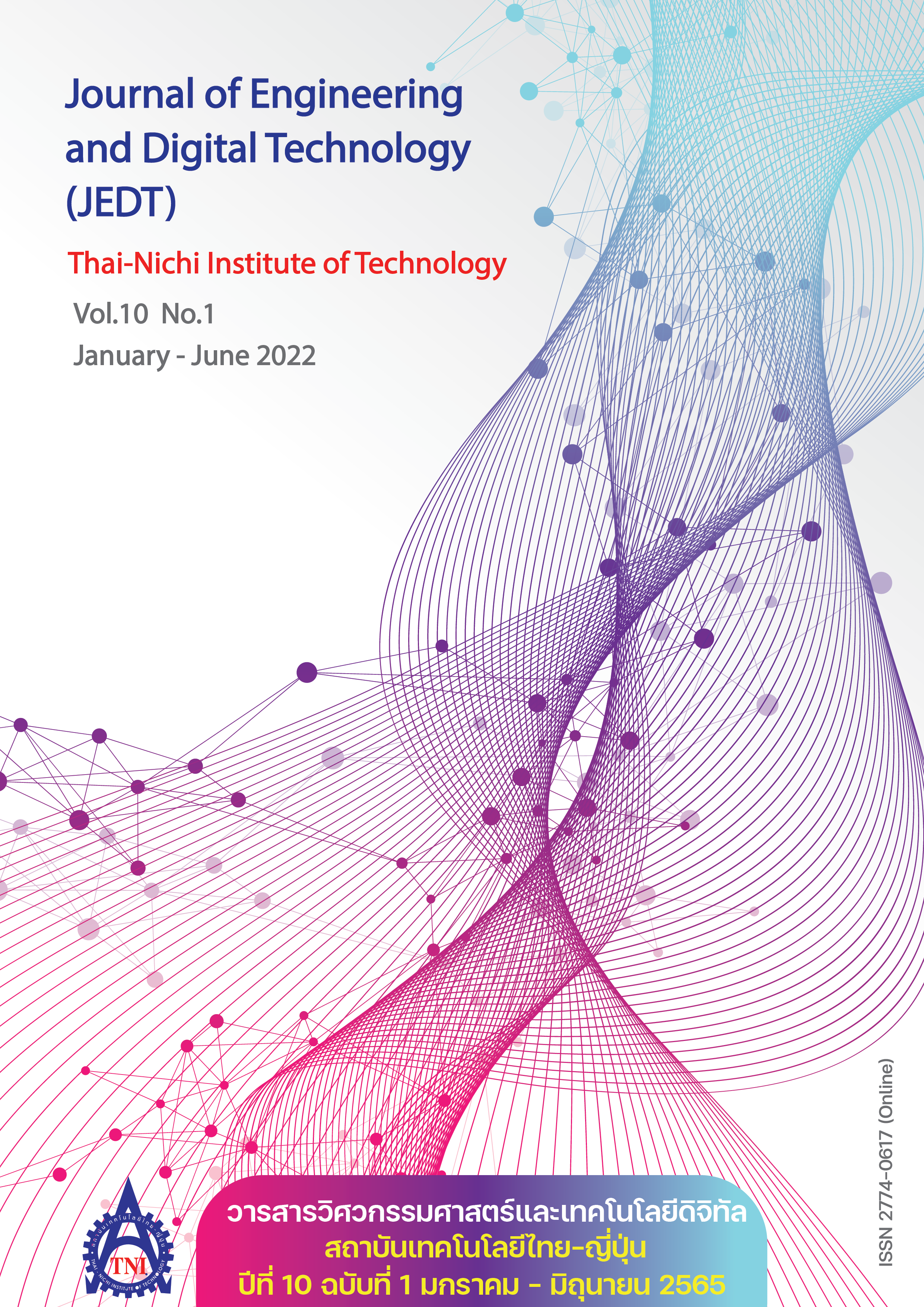Using Deep Learning with Thermal Imaging Camera to Record Employee Attendance System
Main Article Content
Abstract
Today every country in the world faces a COVID-19 situation, making life different from daily life or work life. Therefore, organizations or companies adopt a primary diagnostic method for COVID-19 by having a system to scan an individual facial temperature using a thermal imaging camera to check if that person has initial symptoms of COVID-19 or not. This research focuses on the development of an attendance record system with a thermal imaging camera combination with Deep Learning to optimize the collection and processing of data to classify or identify employees precisely and reduce step to record the working hours of employees. The experiment found an average of face recognition the mean accuracy was 81.85%, and the mean processing time was 0.26 seconds. The research was satisfying when compared the research on the development of a time recording system with face detection and recognition using the Haar-Like Feature technique to detect faces and using the Local Binary Patterns Histogram to recognize faces with accurate of facial recognition at 48%. According to the experiment, the result was highly satisfying in terms of accurate data and processing time. Moreover, the developed system produces accurate and precise information with convenience and safety.
Article Details

This work is licensed under a Creative Commons Attribution-NonCommercial-NoDerivatives 4.0 International License.
Article Accepting Policy
The editorial board of Thai-Nichi Institute of Technology is pleased to receive articles from lecturers and experts in the fields of engineering and technology written in Thai or English. The academic work submitted for publication must not be published in any other publication before and must not be under consideration of other journal submissions. Therefore, those interested in participating in the dissemination of work and knowledge can submit their article to the editorial board for further submission to the screening committee to consider publishing in the journal. The articles that can be published include solely research articles. Interested persons can prepare their articles by reviewing recommendations for article authors.
Copyright infringement is solely the responsibility of the author(s) of the article. Articles that have been published must be screened and reviewed for quality from qualified experts approved by the editorial board.
The text that appears within each article published in this research journal is a personal opinion of each author, nothing related to Thai-Nichi Institute of Technology, and other faculty members in the institution in any way. Responsibilities and accuracy for the content of each article are owned by each author. If there is any mistake, each author will be responsible for his/her own article(s).
The editorial board reserves the right not to bring any content, views or comments of articles in the Journal of Thai-Nichi Institute of Technology to publish before receiving permission from the authorized author(s) in writing. The published work is the copyright of the Journal of Thai-Nichi Institute of Technology.
References
V. Zoumpourlis, M. Goulielmaki, E. Rizos, S. Baliou, and D. Spandidos, “The COVID-19 pandemic as a scientific and social challenge in the 21st century,” Mol. Med. Rep., vol. 22, no. 4, pp. 3035–3048, Oct. 2020, doi: 10.3892/mmr.2020.11393.
J. Sricham. “The day that Thailand knows COVID-19.” (in Thai), THAIPBS.com. https://news.thaipbs.or.th/content/290347 (accessed Sep. 9, 2020).
W. Yawai, K. Sirijinda, and P. Banjongrot, “Mobile application for time attendance system using facial recognition,” J. Project Comp. Sci. Inf. Technol., vol. 4, no. 1, pp. 29–36, 2018.
T. Ahonen, A. Hadid, and M. Pietikainen, “Face description with local binary patterns: Application to face recognition,” IEEE Trans. Pattern Anal. Mach. Intell., vol. 28, no. 12, pp. 2037–2041, 2006, doi: 10.1109/TPAMI.2006.244.
P. Viola and M. Jones, “Rapid object detection using a boosted cascade of simple features,” in Proc. IEEE Comput. Soc. Conf. Comput. Vis. and Pattern Recognit., Kauai, HI, USA, 2001, pp. I-511–I-518, doi: 10.1109/CVPR.2001.990517.
D. Sheel. “What is Deep Learning?.” NEW.ABB.com. https://new.abb.com/news/detail/58004/deep-learning (accessed Sep. 11, 2020).
S. Chintalapati and M. V. Raghunadh, “Automated attendance management system based on face recognition algorithms,” in IEEE Int. Conf. Comp. Intell. and Comp. Res., Enathi, India, Dec. 2013, pp. 1–5, doi: 10.1109/ICCIC.2013.6724266.
J. Sanuksan and O. Surinta, “Deep convolutional neural networks for plant recognition in natural environment,” (in Thai), J. Sci. Technol. Mahasarakham Univ., vol. 38, no. 2, pp. 113–124, 2019.
K. Treeprapin, P. Na-udom, and P. Kongchai, “Developing a system to verify student enrollment with facial recognition method,” (in Thai), J. Sci. Technol., Ubon Ratchathani Univ., vol. 20, no. 2, pp. 92–105, 2018.
P. Jaturawat, P. Pongmanawut, and M. Phankokkruad, “Development of a learning record system with face detection and recognition,” (in Thai), KMITL J. Inf. Technol., vol. 5, no. 1, pp. 1–11, 2017.


